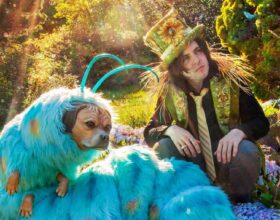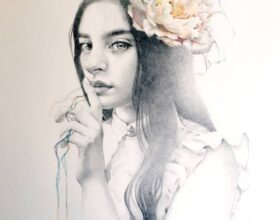Noah Norrid captures all of the vintage charm of natural history illustrations you’d find in museums and juxtaposes it with his flare for surrealism. His paintings have an essence of crisp, yellowed 18th century sketchbooks filled to the brim with pages exploring our natural world. You can almost smell the pungent scent of old books swirling together with a crisp freshness of modernity.
His paintings are populated by majestic birds of all shapes, sizes and colours alongside various flowers and fauna that we all too often take for granted. These birds emphasise the beauty of the natural world brining long forgotten memories to the forefront of our human consciousness. That childhood memory down by the river or those family walks in the forest are all reignited through his work and suddenly these long forgotten memories become treasured larger than life moments.
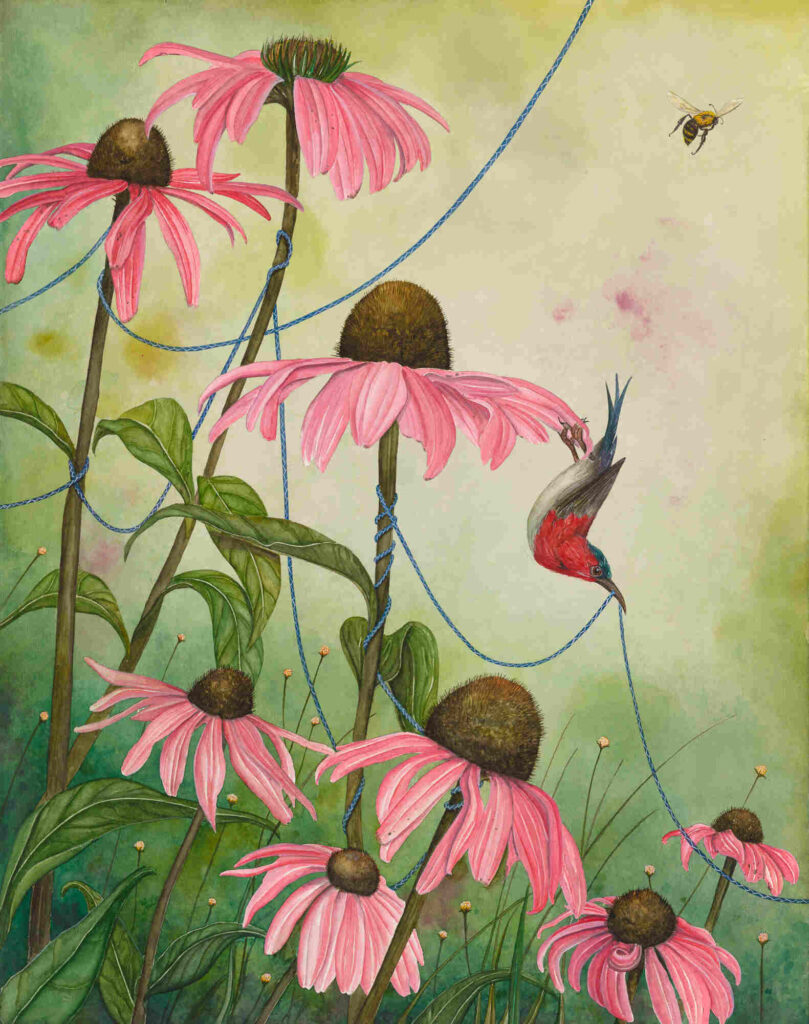
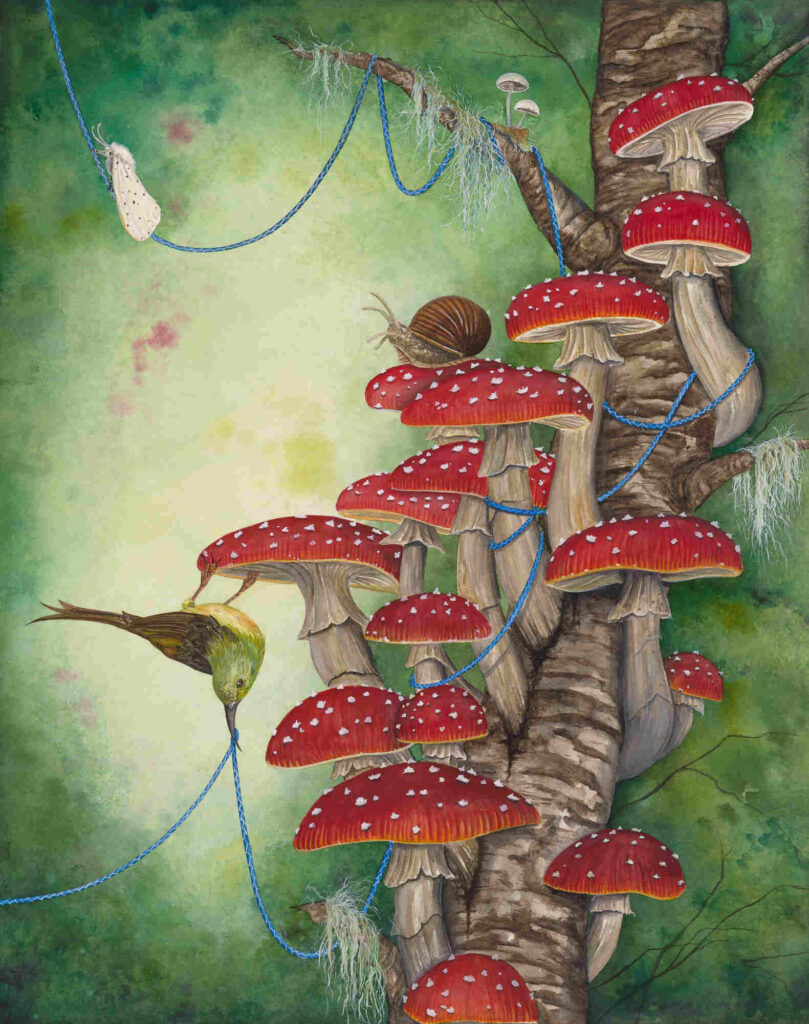
Originally from the Lone Star state of Texas, Noah is a self-taught artist who has always had a passion for art, especially watercolour. He’s spent many years honing his skills in painting, drawing, printmaking, ceramics, sculpting, wood-work and stop-motion animation alongside working his day job as an English and Design teacher. After 20 years of teaching as his main career, Noah decided to diversify and began pursuing art professionally when he and his wife co-created two children’s books. As a blossoming artist, Noah’s work has featured in trade magazines, children’s books and he’s participated in various group exhibitions. Currently, Noah successfully juggles both his creative and teaching pursuits in Copenhagen, Denmark where he resides with his family.
Animals in general, and birds specifically, are so common in our collective psyche that they have developed a kind of elastic capacity to tell both their own story as well as a human one.
Interview with Noah Norrid
I’d love to hear a bit about your background as an artist. What made you want to pursue art and how did you get started?
I took the long road to my art career. As in, the VERY long road with more than a handful of detours. I was always a dabbler in doodles and gravitated towards the arts. When I was studying English composition and literature at the University of North Texas, I minored in ceramics and loved the visceral and physical nature of the clay.
But it was when I moved to Denmark with my wife that I really began to realize that I wanted to get back into art in a more serious way. At that point, the immigration services had lost my paperwork and as a result, I had a rather long, arduous 11 month wait for my work permit. As a result, I had a choice: either play the Xbox for 16 hours a day and go partially insane or use the time to explore a burgeoning interest. The latter suited my assiduous nature and allowed me to retain my self-respect.
As we lived in a small apartment, I didn’t have access to ceramics anymore and there wasn’t a lot of room for a large workspace, I went back to my first love: drawing and watercolour. The only problem was, I had spent the part of 10 years doing everything but drawing and watercolour. Luckily, I had had a great teacher back in high school that had better taught me some good basic skills that came back to me quite easily.
About 5 months later in this creative re-awakening, I had a dream of this boy with a motorcycle helmet on his head. I could just SEE this kid in my mind and I knew that he had a story to tell. So…long story short, I poured more or less all of my creative focus into developing this character and, lo and behold, in 2011, my wife and I had our first children’s book published. My wife and I co-wrote the text and I illustrated it. I only found out later that most REAL artists/illustrators don’t cut their teeth on such a lofty project goal. This pretty much sums up a lot of how things have worked out for me in life.

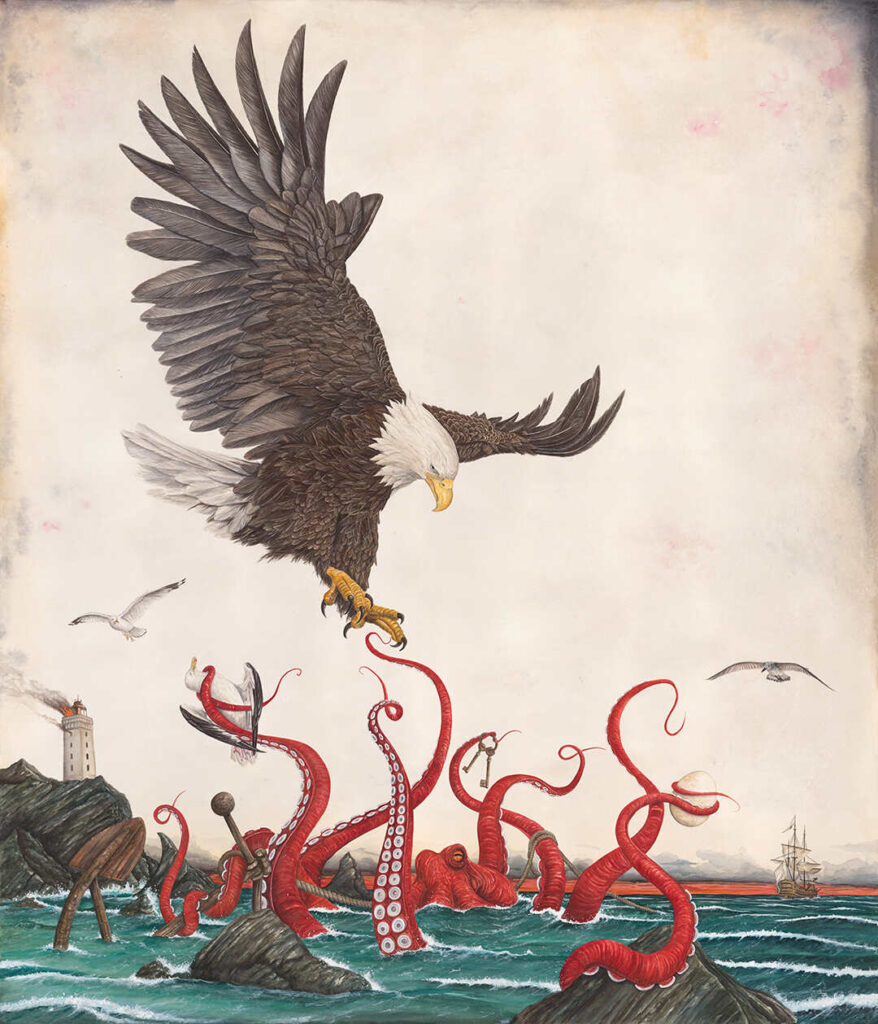
What is your earliest memory of making art?
I think my best early memory of making art was when I felt I had graduated from coloring books and copying comic book characters and coffee table animal-in-nature books and my dad enrolled me in a summer drawing class at Amarillo City College. My mom had recently past away and my father was still learning how to walk again on his prosthetic leg (car accident) – so that summer was filled with many firsts.
I remember my dad took me to the art supply store and I felt this wave of giddiness wash over me. It was one of those rare blank-check moments where my dad gave me the run of the place, saying, “get what you need.” I went on a total shopping spree! The pencils. The brushes. All the colours in nifty, fancy looking tubes…it felt like I had entered a toy store for the first time in my life: I was ten feet tall and walking in clover.
Of course, when I got home with this armload of art supplies, the wave of giddiness turned into a bite of expectation and fear. While the three week art class was great – it turned out to be mostly basic drawing techniques (that I needed and loved) and I didn’t end up using even half of what we had splurged on that summer. Instead, I ended up playing with the watercolours on and off in fits and starts all the way up until high school – which was where I really learned how to use the medium effectively and with some command. But this memory sticks out I think because it was one of those rare places that my dad and I shared a calm and open space. This is the sort of place that I arrive at when I am in a good groove of work. I still get the same giddiness when I go into an art supply store. It feels like a disease.
Sometimes you just have to stand with the brush in hand and then your body knows what to do.
Birds are an overarching theme throughout your work and you discuss on your website how they are highly symbolic creatures that appear in our collective consciousness. What do you think it is about birds that make them so symbolic?
Probably the simplest reason why birds inform so much of our mythologies and collective consciousness is the fact that they are everywhere. In order for something to be an effective symbol, it has to be easily understandable by a broad set of the population and I think we all can look at a bird and draw out the implicit connotations that these animals have and continue to have. For example, a wing suggests more than a piece of avian anatomy and points to ideas of freedom, flight, power, delicacy…all depending on the context of that simple wing finds itself in.
As well, regardless of the various species and sub-species of birds, as well as the various cultural garb and geographic location of any given society, or the various time periods, the fundamental truth is that birds are such powerful symbols because they are experienced so readily and, in spite of the vast variations, still remain essentially the same in terms of the symbolic possibilities. I think what I’m trying to get across here is that animals in general, and birds specifically, are so common in our collective psyche that they have developed a kind of elastic capacity to tell both their own story as well as a human one.
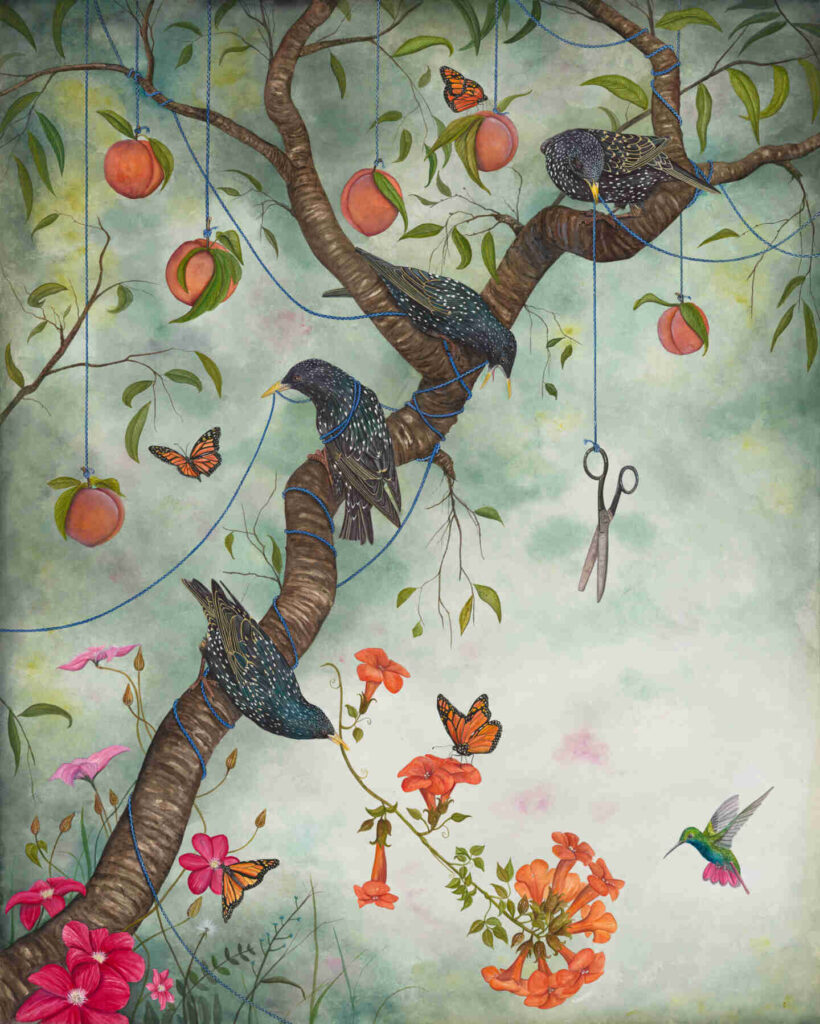
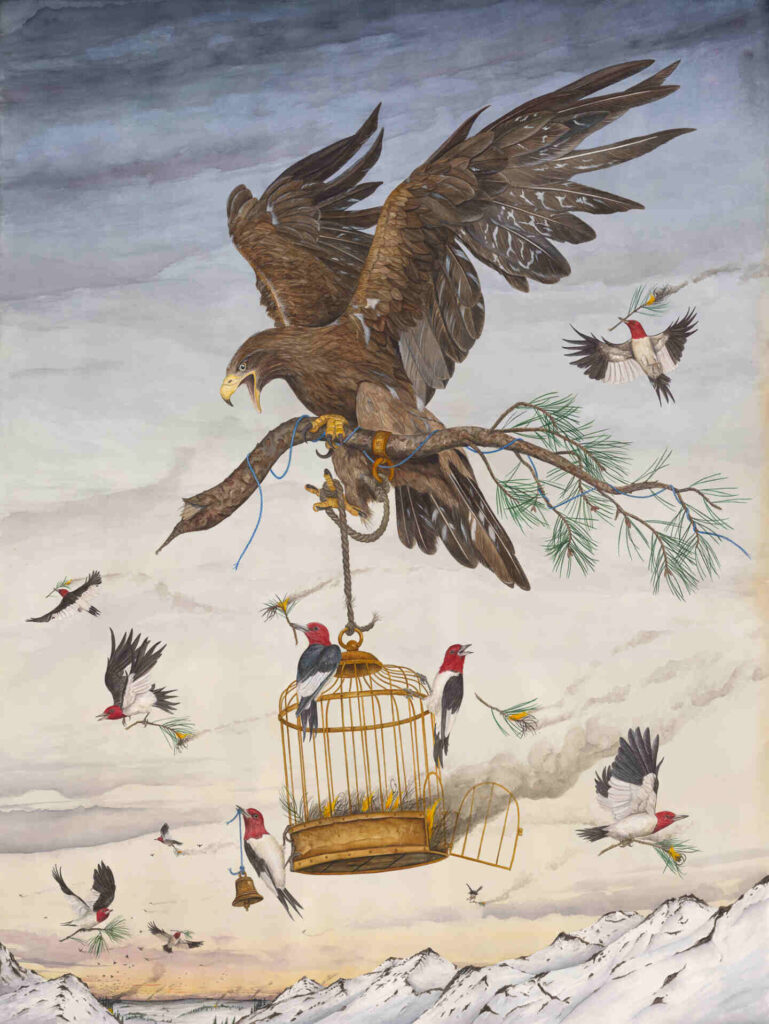
Are birds something you feel personally connected to?
Yes. I spent many of my summers with my grandmother and my aunt in a small town in west-Texas called Knox City. My mom’s family were all bird fans and the house was decorated with various small dime-store statues of common birds and the garden outside was a regular west-Texas bird ghetto, housing all manner of jays, robins, and mockingbirds – all jockeying for evening-rights at the birdbath that sat white and cool at the center of the early evening shade of the mulberry tree.
Also, I remember my grandmother had a few of these John James Audubon prints that my grandfather had given her as some gift ages ago that she had framed and proudly hung about the house. These old Audubon prints were some of the first illustrations that had caught my attention, but I am not certain why. I was reminded of these prints later in life when my one surviving aunt mailed me the folio of all these Audubon prints. When I received these prints, it coincided with the transitional point I was having in my art and I was looking for direction. I think this Audubon folio was pretty significant because it gave me a familiar touchstone. And like I said, this coincided, rather serendipitously, with the place I was at in my life as I was struggling to find my way. So yeah. It is a personal connection.
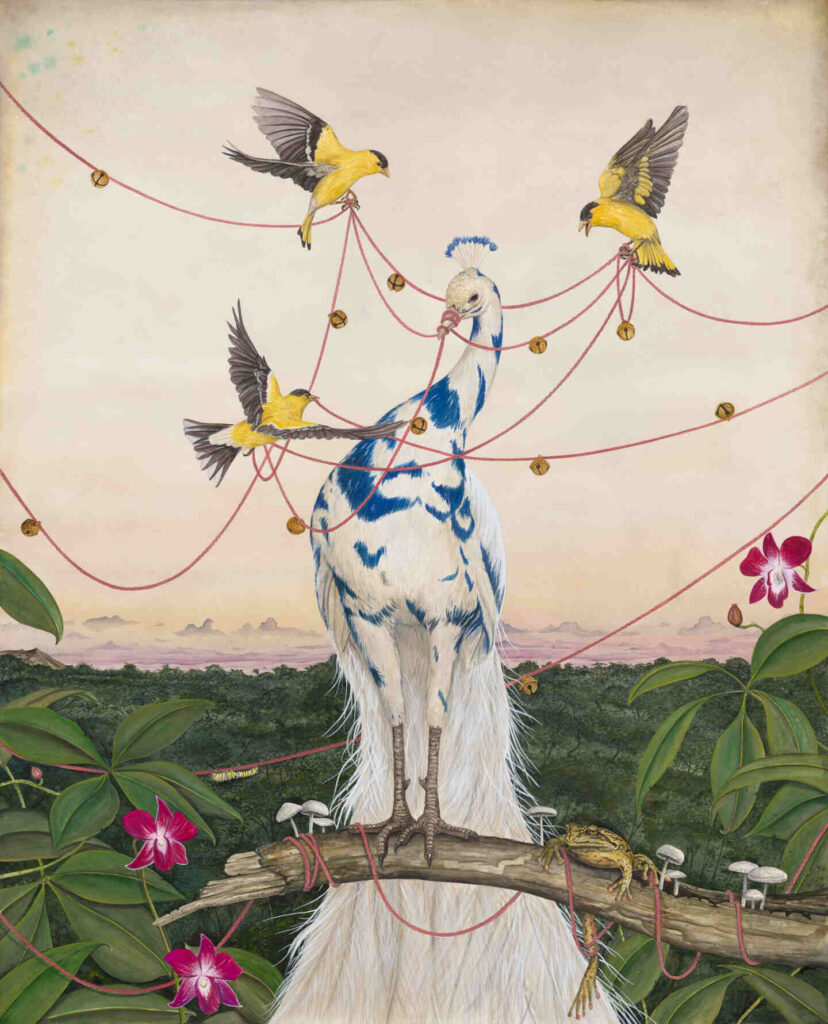
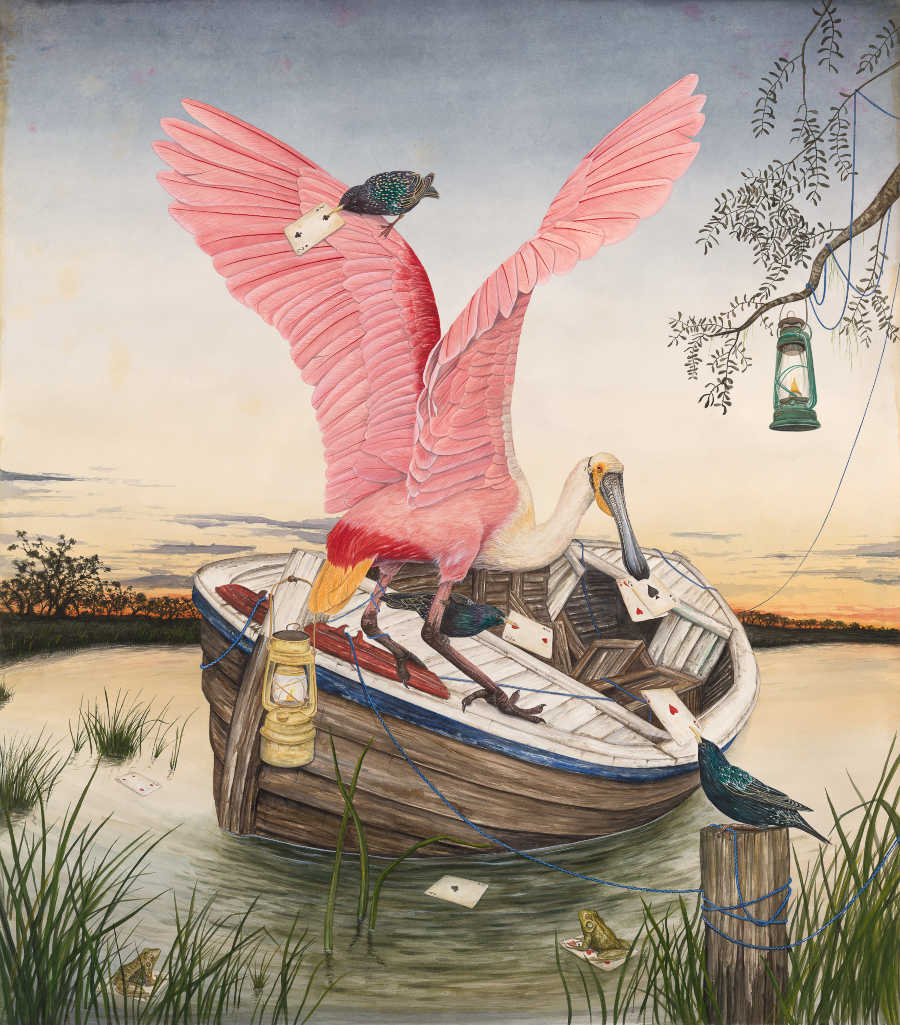
Do you have a favourite type of bird?
Not really. It’s a bit like asking a painter what his/her favorite colour is. There are some birds that I return to in my work because I draw likeness to their inherent nature. The Rosette Spoonbill has a lovely, gregarious nature that I think is beautiful to watch and depict. While hiking in Big Bend National Park recently, I fell in love with this little mob of Mexican Jays that appeared pretty debonair and adventurous in coercing me to give them peanuts from my backpack. I’m getting excited about exploring those possibilities in a future work. And here at home, we have some magpies and crows that seem to be in near perpetual warfare with each other over the pecking rights to our garden…yet seem to come together in common cause to empty the birdfeeder when my wife decides to feed them.
What I can say to that is that there are some types of birds that lend themselves to certain types of narratives while other birds have difficulty in carrying or sheading a kind of narrative typecasting. Owls, for example. Owls have such a characteristic demeanour that it is difficult to cast them in narrative works without there being this kind of interference or baggage that comes with the popular conceptions of owls. In some cases, one can play with these popular conceptions of individual species and that can be part of the narrative and compositional process.
I think the single most important habit that I have developed is the idea that I have to DO something every day….regardless of how tired I am. When I have a piece that I am working on, I HAVE TO give it at least 10 minutes of my time.
Your work infuses natural history illustrations with surrealism. What inspired you to mix these two styles together?
Well, I touched on this earlier. After I had finished our second children’s book, I was a bit listless and uncertain what I wanted to work on next. That folio of Audubon prints had come by mail and felt that I was on the verge of something, but I just didn’t know what. I was poking around my library when I ran across an old copy of Aesop’s fables that I had had from college and I began reading these fun but, in some instances, horrific stories. Yet the illustrated etchings featured the very familiar anthropomorphism that is so often rendered when animals are the lead characters in stories.
I began to wonder what an illustrated volume of Aesop’s fables would look like if it used anatomically correct renderings of the animal characters presented in the natural world. This was how the beginnings of my current work started. You can see my first attempt on my website, called “The Vain Crow” which is the first result of that question. After a few experiments, I started to add my own narrative twists in the paintings and then I began departing Aesop’s fables all together and began telling my own stories.

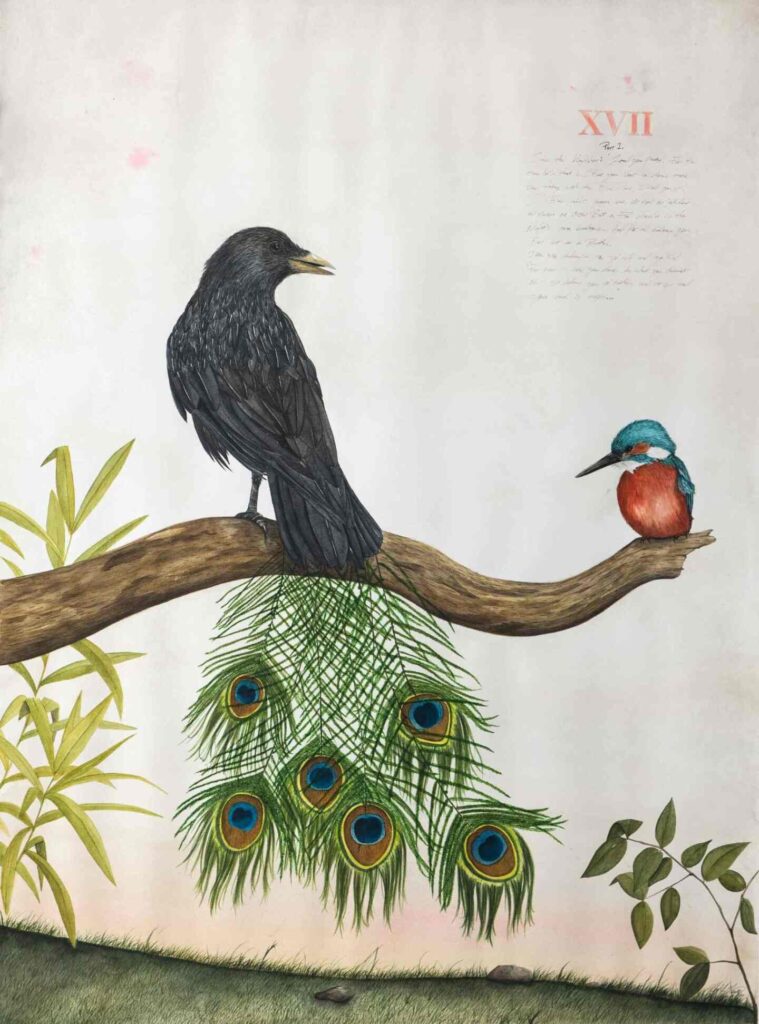
As both natural history and surrealism influence your paintings, I was wondering who are some of your influences?
Well, pretty much any artist or illustrator that works inside those genres tend to capture my attention and sends my mind reeling to the good places. Obviously, Walton Ford had a strong impact on my work, but mostly because his work showed me what was possible in the scope of my chosen medium and genre. As I’ve progressed through the years, and have been more and more active on social media, I’ve been exposed to a considerable number of phenomenal artists and their work that resonate with my own and who continue to inspire me in my own storytelling work: El Gato Chimney, Bill Mayer, Adonna Khare, Victor Grasso, Jon Ching, Carolyn MacDonald, Greg Oakley, Kristen Moore, Ragnhildur Ágústsdóttir, William Higginson, Steven Kenny, Tune Anderson, Troels Carlsen, Martin Wittfooth, Julio Reyes, Phillip Singer, Alvaro Naddeo, Rance Jones, Marald van Haasteren, Jeremy Geddes, Christina Mrozik, and Bruno Pontiroli. Just to name a few!
I understand that narrative is what drives ideas for your paintings. How do you approach a new piece of work? Do you write down ideas before sketching anything out?
I think both. When I get ideas, I do a rough thumbnail sketch that captures the overall compositional form as I experience it in the moment. The margins of the paper are usually filled with notes and comments on what I might consider, details to include, colour combinations, type of bird, gestures, dispositions, etc. I fill these out later on as I try filling out the work and seeing how it actually fits together with details. But there are sometimes where I might describe what my idea because I am in a pinch for time and I don’t what to rush the sketch.
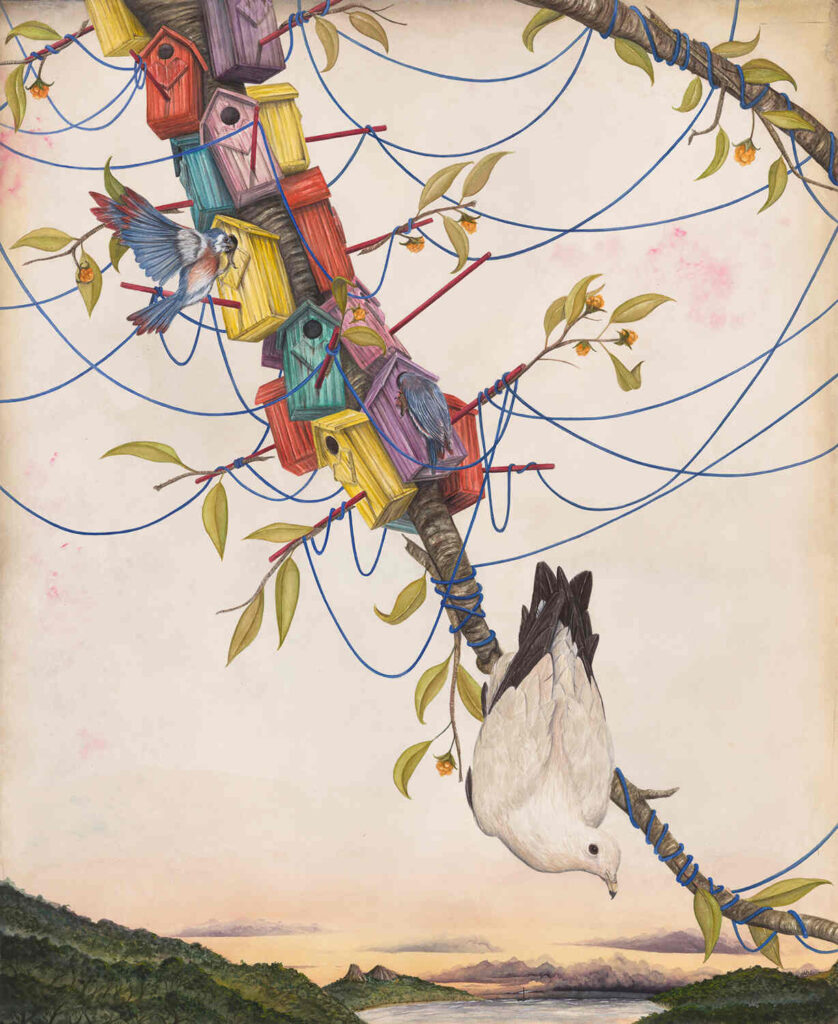

Can you tell us a bit about your studio space?
Well…it really is just our dining room table. I work mostly with pan watercolours and usually only with a collection of 4-6 brush types for any painting. Like most artists, this has been a side hustle for so long that I needed to find efficient ways for me to quickly get into my materials and to my work. The best way, I found, was to keep myself accessible to my family and centered in our daily activities. I think this has been one of the central elements to my ability to progress even through chaotic and busy periods of our lives. After all, it is easier to get back to work when your materials are close at hand rather than in some creative cave in the back reaches of the house. I think this way of working came as a result of limited resources and space when we moved back to Denmark. I stuck with it because it worked. Though, I will say that with my eldest son turning eighteen next year, I am eyeballing his bedroom in the coming years for even larger formatted works that I would like to explore and develop.
I think that I have 2 super powers. I think the fact that I am a self-taught artist with a background in literature and composition gives me more than a few advantages in the way I view narrative aspects of any given work.
What are some creative habits that you have developed as an artist over the years?
I think the single most important habit that I have developed is the idea that I have to DO something every day….regardless of how tired I am. When I have a piece that I am working on, I HAVE TO give it at least 10 minutes of my time. If I’m between pieces, I HAVE TO give myself 10 minutes with the sketch. I HAVE TO do something that is productive for the work at hand. This does not include the business aspect of these activities. In practice, these habits have nearly always lead to 30 minute to hour long sessions that served to reinvigorate me. Sometimes you just have to stand with the brush in hand and then your body knows what to do.
I think another habit that I have that has been pretty good for me has been to stick to one piece at a time and work through it to completion. I think this helps keep the flow and excitement in the work. I am often tempted to work on more works at once – but every time I’ve tried, I get confused, and I feel as though it breaks up the individual work’s cohesion.


My other superpower is the firm belief that regardless of the finished outcome of any given work, I remain convinced that my best work is still ahead of me. This keeps me and my work moving forward.
What is your artistic superpower and how does it make your work unique?
I think that I have 2 super powers. I think the fact that I am a self-taught artist with a background in literature and composition gives me more than a few advantages in the way I view narrative aspects of any given work. Time, tenacity, patient internal critique and more than my fair share of luck has allowed me to hone the technical skills of my craft and learn how to work on my work. But understanding how stories work and how they engage “readers” and draw them out into curious and vulnerable places via symbols, tensions, the interplay between foreground and background, the disassociated detail as foreshadowing…these are ideas that I might not have considered had I pursued a more traditional path. Granted, I would have other strengths had that been the case.
My other superpower is the firm belief that regardless of the finished outcome of any given work, I remain convinced that my best work is still ahead of me. This keeps me and my work moving forward.
Finally, what’s next for you? Any exciting projects in the works that you can tell our readers a bit about?
Later this year, I’ll be breaking out of the art scene in Denmark and will be working with Quirky Fox Gallery in New Zealand, which I am pretty excited about. Also, I’ve been exploring new larger scale works that will branch out with new animal characters. There are some other things bubbling in the background at the moment, but I can’t say much about these yet.


